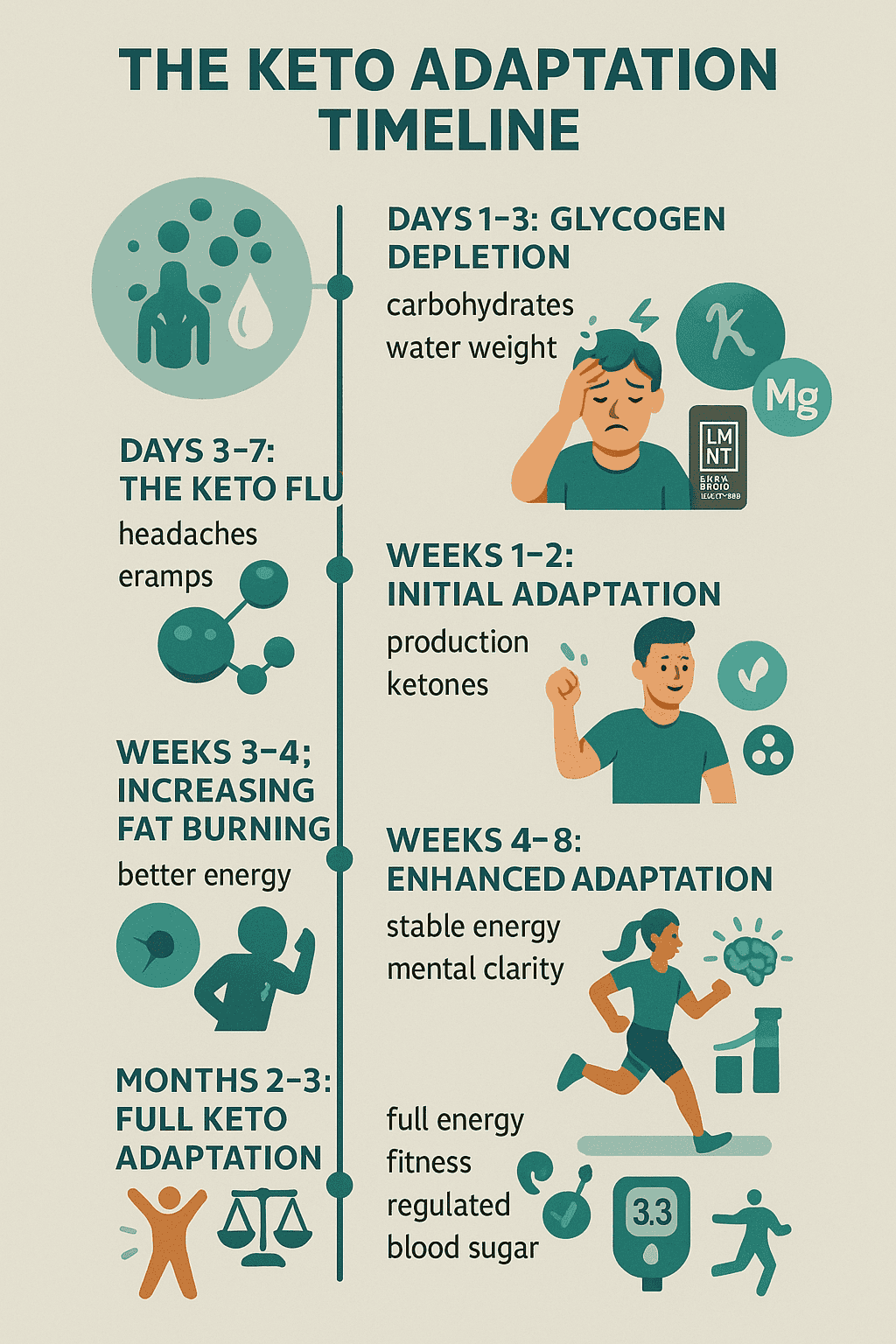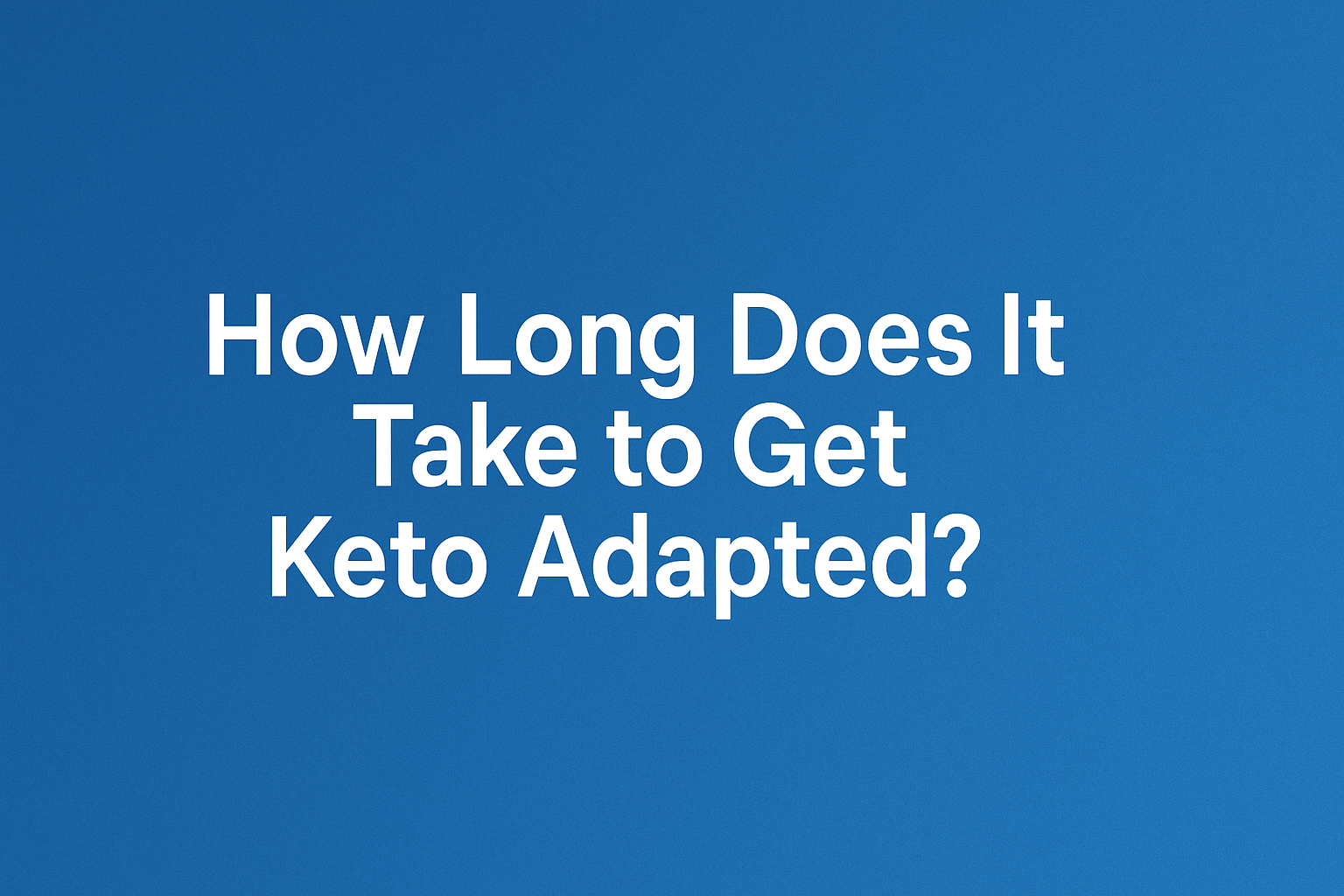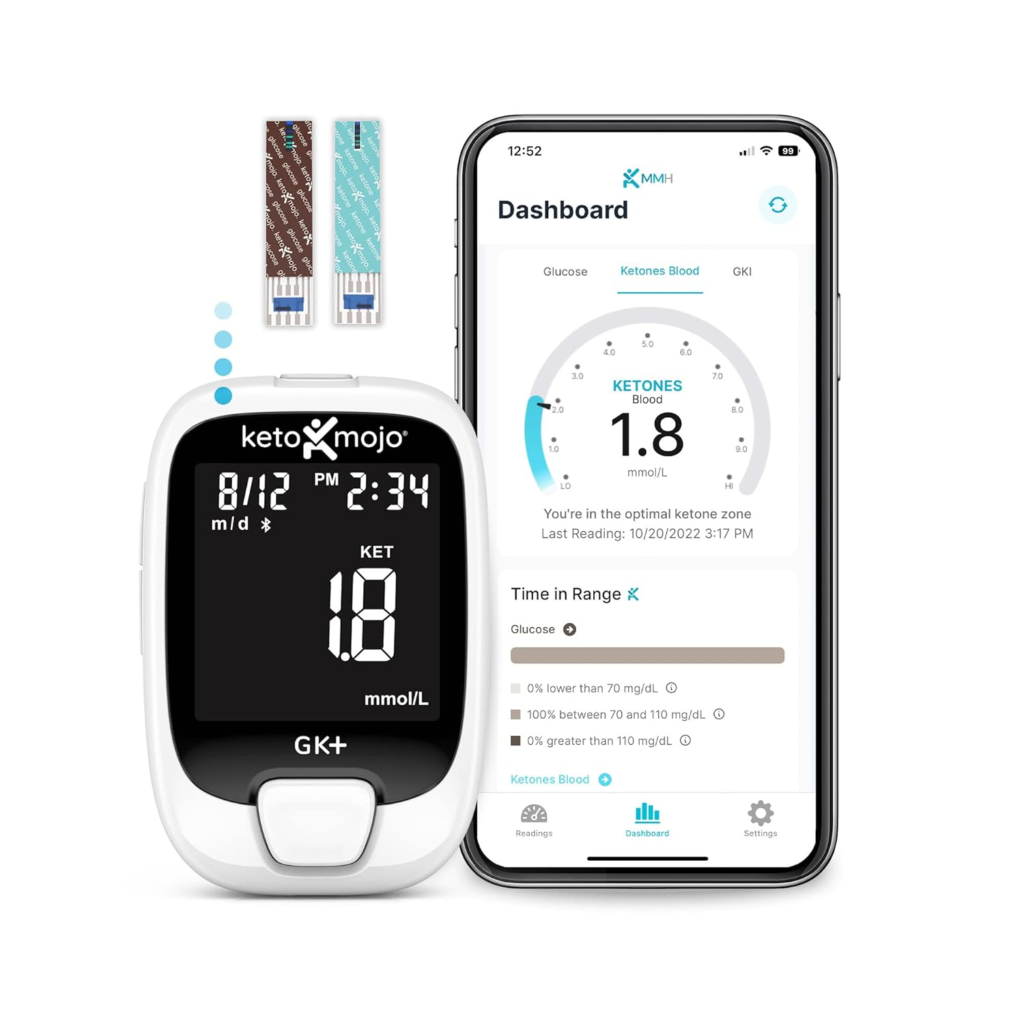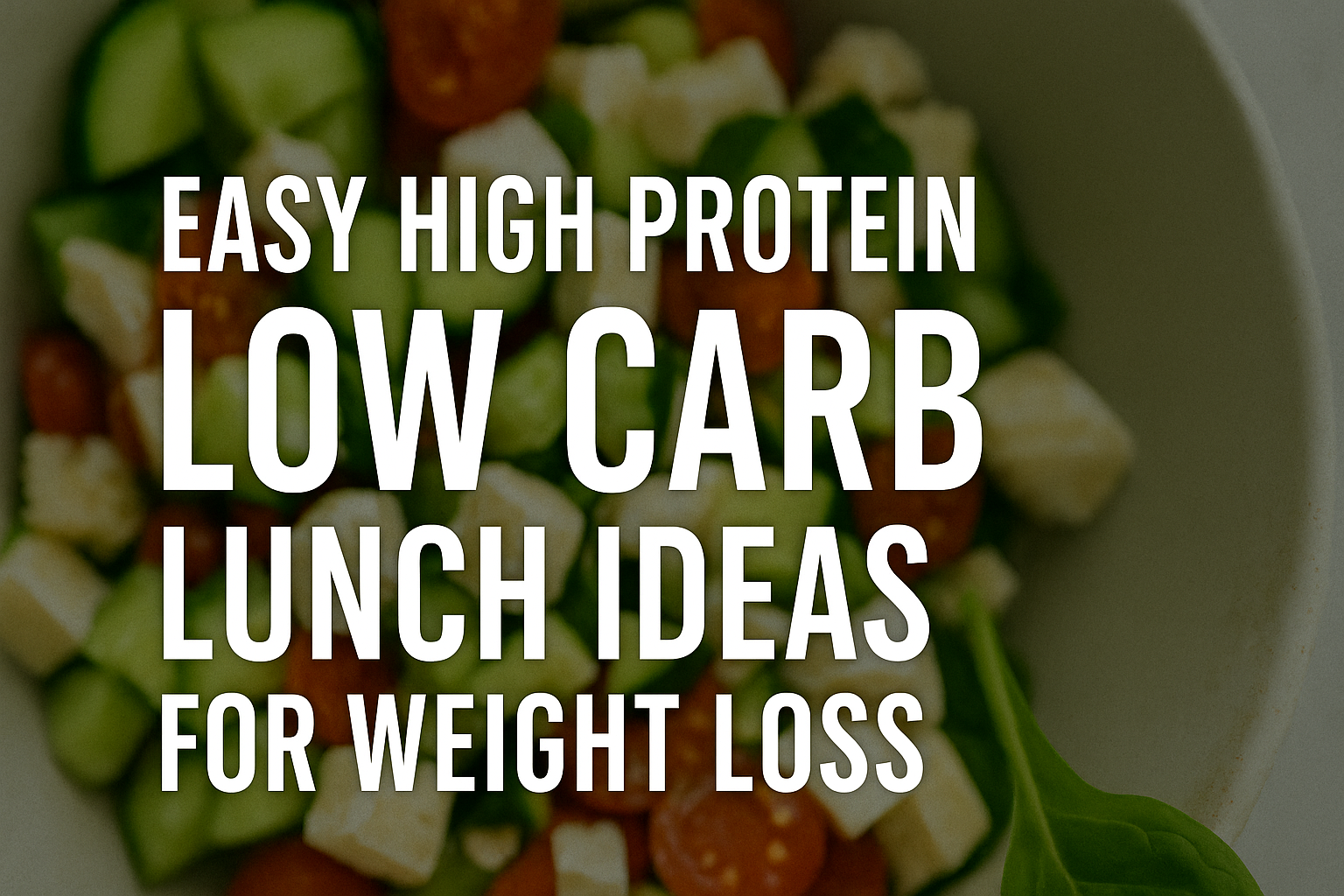How Long Does It Take to Get Keto Adapted? Let Me Tell You What Really Works
If you’re reading this, you’re probably wondering: When will this keto thing actually start working? I get it – I’ve been there. That frustrating phase where you’re eating all the bacon but still feeling sluggish, cranky, and wondering if this “fat-adaptation” thing is just a myth.
Here’s the truth from someone who’s been through it: keto adaptation isn’t instant, but when it happens, it’s life-changing. I’ll never forget the morning I woke up after about 3 weeks and realized I wasn’t hungry for breakfast. Or when I powered through an afternoon meeting without my usual 3pm energy crash. That’s when I knew my body had finally made the switch.
In this guide, I’ll share:
- The real timeline you can expect (it’s not the same for everyone)
- How to know if you’re truly fat-adapted (beyond just testing ketones)
- My personal tricks for getting through the adaptation phase faster
- The supplement that saved me from keto flu (I still use it daily)
Tip! You can also jump right over to buy it here!
Affiliate Disclaimer: Some links in this article may earn me a small commission at no extra cost to you. I only recommend products I truly use and believe in.
Ready to finally become that fat-burning machine everyone talks about? Let’s dive in.
The Science of Keto Adaptation
Keto adaptation, also known as fat adaptation, occurs when your body shifts from relying primarily on glucose for energy to efficiently using fat and ketones as fuel. This metabolic flexibility is a natural state that humans evolved to handle periods of low food availability.
When you drastically reduce carbohydrate intake (typically to under 50g per day), your body goes through several key physiological changes:
- Glycogen depletion: Your body burns through stored carbohydrates in your liver and muscles.
- Increased fat breakdown: As glucose becomes scarce, your body ramps up the breakdown of fatty acids for energy.
- Ketone production: Your liver starts producing ketone bodies from fatty acids to provide an choice fuel source for your brain and other organs.
- Enzyme and transporter changes: Your cells upregulate the enzymes and transporters needed to efficiently use fat and ketones for energy.
- Mitochondrial changes: The number and efficiency of mitochondria (your cellular powerhouses) increase to better handle fat oxidation.
- Brain adaptation: Your brain, which typically relies heavily on glucose, adapts to use ketones for up to 70% of its energy needs.
These changes don’t happen overnight. The timeline for full keto adaptation can vary significantly from person to person.
Factors Affecting Keto Adaptation Time
Several key factors influence how quickly your body can make the switch to primarily burning fat for fuel:
- Previous diet: If you’re coming from a standard high-carb diet, it may take longer for your body to adapt compared to someone who was already following a lower-carb eating plan.
- Metabolic flexibility: Some people naturally have a greater ability to switch between fuel sources.
This genetic predisposition can speed up the adaptation process.
- Activity level: Regular exercise, especially high-intensity workouts, can accelerate keto adaptation by depleting glycogen stores more quickly and increasing mitochondrial efficiency.
- Genetics: Your genetic makeup influences how efficiently your body produces and uses ketones.
- Adherence to the diet: Strict adherence to a very low-carb diet leads to faster adaptation than a more lenient approach.
- Age and health status: Younger, healthier people often adapt more quickly than older adults or those with metabolic issues.
- Stress levels: High stress can impede adaptation by increasing cortisol, which can raise blood sugar levels.
The Keto Adaptation Timeline
While everyone’s experience is unique, here’s a general timeline of what you might expect during the keto adaptation process:
Days 1-3: The Glycogen Depletion Phase
In the first few days of drastically reducing carbs, your body burns through its glycogen stores. You might experience rapid fat loss during this time, but it’s primarily water weight as glycogen holds onto water.
Some people feel great during this phase, while others may start to experience early signs of the “keto flu.”
Days 3-7: The Keto Flu
As your body struggles to adapt to its new fuel source, you might experience what’s known as the “keto flu.” Symptoms can include fatigue, headaches, irritability, brain fog, and muscle cramps. This is often because of electrolyte imbalances and can be mitigated by increasing your intake of sodium, potassium, and magnesium.
I remember feeling like I had been hit by a truck on day 4 of my first keto experiment. Increasing my salt intake and taking magnesium supplements made a world of difference.
Combat the dreaded keto flu before it hits – replenish lost electrolytes with LMNT. Packed with sodium, potassium, and magnesium, it’s formulated for keto.
Weeks 1-2: Initial Adaptation
By the end of the first week, your body will be producing ketones, but it may not be fully effective at using them yet. You might start to notice improvements in energy levels and mental clarity.
Many people report feeling “lighter” and less bloated during this phase.
Weeks 3-4: Increasing Fat Burning
Around this time, many people start to feel more energized and notice a decrease in cravings. Your body is becoming more adept at burning fat for fuel.
Exercise performance, which may have dipped initially, often starts to improve.
Weeks 4-8: Enhanced Adaptation
During this period, you’ll likely experience more stable energy levels throughout the day. Athletic performance continues to improve, and many people report enhanced mental clarity and focus.
Months 2-3: Full Keto Adaptation
For most people, full keto adaptation occurs within this timeframe. You’ll likely feel fully energized, have stable blood sugar levels, and experience enhanced mental clarity and focus.
Your body has become highly effective at using fat and ketones for fuel.

Overcoming Challenges During Adaptation
The path to keto adaptation isn’t always smooth sailing. Here are some common challenges and how to overcome them:
Electrolyte Imbalances
When you reduce carbs, your body excretes more water and electrolytes. This can lead to symptoms like headaches, muscle cramps, and fatigue.
To combat this:
- Increase your intake of salt. Add sea salt or pink Himalayan salt to your food and water.
- Eat potassium-rich foods like avocados, spinach, and salmon.
- Consider taking a magnesium supplement, especially before bed to help with sleep and muscle relaxation.
Recommended Product: Doctor’s Best High Absorption Magnesium
Dehydration
The initial water loss can be significant. Drink plenty of water throughout the day, aiming for at least 2-3 liters.
A good rule of thumb is to drink enough that your urine is pale yellow.
Digestive Issues
Your gut microbiome may need time to adjust to your new diet. Some people experience constipation or diarrhea during the adaptation phase.
To help:
- Ensure you’re getting enough fiber from low-carb vegetables.
- Consider adding fermented foods like sauerkraut or kimchi to your diet.
- A probiotic supplement can also be helpful.
Recommended product: Physician’s CHOICE Probiotics
Exercise Performance Dips
Don’t lose hope if your workouts initially suffer. Your performance will likely improve once you’re fully adapted. In the meantime:
- Reduce workout intensity if needed.
- Focus on maintaining form and technique rather than pushing for personal bests.
- Consider adding some extra salt before workouts to help with hydration and electrolyte balance.
Cravings
Carb cravings are common during the adaptation phase. They typically subside as you adapt. To manage them:
- Ensure you’re eating enough fat to feel satiated.
- Keep keto-friendly snacks on hand for emergencies.
- Stay busy and distracted during times when cravings typically hit.
Pro Tips for Speeding Up Keto Adaptation
While patience is key, there are a few strategies that might help accelerate your adaptation:
1. Intermittent Fasting
Incorporating periods of fasting can help reduce glycogen stores more quickly and boost ketone production. Start with a 12-hour overnight fast and gradually increase the fasting window if desired.
Read more about Intermittent Fasting in this article: Keto Diet and Fasting: The Powerful Synergy of Ketogenic Eating and Intermittent Fasting
2. MCT Oil
Medium-chain triglycerides are easily converted to ketones and can provide a quick energy boost during the adaptation phase. Start with small amounts (1 tsp) and gradually increase to avoid digestive discomfort.
Need a fast fuel source while adapting? Add a splash of MCT oil to your coffee or smoothie for quick ketone energy.
Recommended Product: Bulletproof Brain MCT oil or Nature’s way Organic MCT oil
3. Electrolyte Supplementation
Staying on top of your electrolytes from day one can help minimize adaptation symptoms. Consider using an electrolyte supplement designed for keto dieters.
Tip! If you’re looking for something differtent than electrolyte powder, I recommend Keto Chow Electrolyte Drops. Read my Keto Chow Electrolyte Drops Review why I recommend it.
4. Gradual Carb Reduction
Some people find success in gradually reducing carbs over a few weeks as opposed to cutting them out all at once. This can help minimize side effects and make the transition more manageable.
5. Stress Management
High stress levels can impede adaptation. Prioritize stress-reducing activities like meditation, yoga, or nature walks.
Getting adequate sleep is also crucial for managing stress and supporting adaptation.
6. Increase Healthy Fat Intake
Ensuring you’re consuming enough healthy fats can help your body transition to using fat for fuel more quickly. Focus on sources like avocados, olive oil, coconut oil, and fatty fish.
7. Stay Active
While intense exercise might be challenging during the early adaptation phase, light to moderate activity can help reduce glycogen stores and encourage your body to start using fat for fuel.
Measuring Your Progress
How do you know if you’re becoming keto-adapted? While the most reliable indicator is how you feel, there are some goal measures you can use:
1. Ketone Levels
Blood ketone meters can give you a precise measurement of your ketone levels. Levels above 0.5 mmol/L show nutritional ketosis.
However, keep in mind that higher ketone levels don’t necessarily mean better results.
Recommended Product: KETO-MOJO GK+ Bluetooth Glucose & Ketone Testing Kit. In my KETO-MOJO GK meter review you can read why I recommend it.
2. Glucose Levels
As you become adapted, your fasting blood glucose levels should stabilize. Many people find their blood sugar stays in a tighter, healthier range throughout the day.
3. Body Composition
Many people notice changes in body composition, particularly a reduction in body fat percentage. Taking measurements or progress photos can be helpful for tracking these changes.
4. Energy Levels
Consistent energy throughout the day is a positive sign of adaptation. You should notice fewer energy crashes and a reduced need for snacks between meals.
5. Exercise Performance
Once adapted, many people find they can exercise for longer periods without needing to refuel. Endurance athletes often report improved performance and recovery.
6. Hunger and Cravings
Reduced hunger and fewer cravings, especially for carb-heavy foods, are signs that your body has adapted to using fat for fuel.
7. Mental Clarity
Many people report improved focus and mental clarity once fully keto-adapted. You might notice you’re more productive and less prone to brain fog.
The Long-Term Benefits of Keto Adaptation
Becoming keto-adapted offers several potential health advantages:
1. Improved Insulin Sensitivity
A ketogenic diet can help improve insulin sensitivity, which is particularly beneficial for people with type 2 diabetes or metabolic syndrome. This can lead to better blood sugar control and reduced risk of related health issues.
2. Enhanced Cognitive Function
Many people report improved mental clarity and focus on a ketogenic diet. Some research suggests that ketones may have neuroprotective properties, potentially benefiting brain health long-term.
3. Reduced Inflammation
A ketogenic diet has been shown to have anti-inflammatory effects throughout the body. This could potentially help with conditions related to chronic inflammation, such as arthritis or autoimmune disorders.
4. Increased Longevity
Some studies suggest that ketosis may have anti-aging effects at the cellular level. While more research is needed, the metabolic changes associated with keto adaptation may contribute to healthier aging.
5. Better Appetite Control
Many people find it easier to maintain a healthy weight once keto-adapted. The combination of stable blood sugar and increased satiety from fat can lead to naturally reduced calorie intake without feeling deprived.
6. Improved Lipid Profiles
Contrary to what you might expect from a high-fat diet, many people see improvements in their cholesterol levels on a well-formulated ketogenic diet. This often includes increased HDL (good) cholesterol and decreased triglycerides.
7. Enhanced Athletic Performance
While the initial adaptation period can be tough for athletes, many report improved endurance and recovery once fully keto-adapted. This is particularly true for endurance athletes.
Frequently Asked Questions
How long does it take to get into ketosis?
Getting into ketosis typically takes 2-4 days of strict carbohydrate restriction (usually under 20-50g per day). However, being in ketosis is just the first step towards full keto adaptation.
Can I speed up keto adaptation?
While the process takes time, strategies like intermittent fasting, MCT oil supplementation, and staying active can potentially speed up adaptation.
Will I lose muscle on a keto diet?
With adequate protein intake and resistance training, muscle loss is not typically a concern on a well-formulated ketogenic diet.
Is the keto flu necessary for adaptation?
While many people experience some symptoms of the keto flu, it’s not a required part of the process. Proper electrolyte management can significantly reduce or eliminate these symptoms.
Can I ever eat carbs again after becoming keto-adapted?
Once keto-adapted, many people find they can incorporate occasional higher-carb meals without fully disrupting their adaptation. However, frequent high-carb eating will reverse the adaptation process.
Is a ketogenic diet safe long-term?
For most healthy people, a well-formulated ketogenic diet can be safe long-term. However, it’s always best to work with a healthcare provider, especially if you have any pre-existing health conditions.
How do I know if I’m fully keto-adapted?
Signs of full keto adaptation include stable energy levels, improved exercise performance, reduced hunger, and mental clarity. Some people also use blood ketone measurements, with levels consistently above 0.5 mmol/L indicating nutritional ketosis.
Can I do keto if I’m vegetarian or vegan?
Yes, it’s possible to follow a ketogenic diet as a vegetarian or vegan, although it needs careful planning to confirm adequate protein and nutrient intake.
Will keto help me lose weight?
Many people experience fat loss on a ketogenic diet, particularly in the initial stages. However, long-term weight management still relies on overall calorie balance.
Can keto help with my diabetes?
A ketogenic diet can potentially improve blood sugar control and insulin sensitivity, which may be beneficial for people with type 2 diabetes. However, it’s crucial to work closely with your healthcare provider if you have diabetes and are considering a keto diet.
Key Takeaways:
- Keto adaptation typically takes 2-8 weeks but can vary widely between people.
- The process involves significant metabolic changes, including increased ketone production and enhanced fat-burning capacity.
- Factors like previous diet, activity level, and genetics can influence adaptation speed.
- Common challenges during adaptation include the “keto flu,” electrolyte imbalances, and temporary dips in exercise performance.
- Strategies like intermittent fasting and proper electrolyte supplementation may help speed up the adaptation process.
- Long-term benefits of keto adaptation can include improved insulin sensitivity, enhanced cognitive function, and better appetite control.










